Spatiotemporal Variations of Reference Evapotranspiration and Its Climatic Driving Factors in Guangdong, a Humid Subtropical Province of South China
Abstract
:1. Introduction
2. Materials and Methods
2.1. Study Area and Meteorological Data
2.2. Reference Evapotranspiration Computation
2.3. Climatic Trend
2.4. Assessing the Impact of Climate Variables on ET0
3. Results
3.1. Change Trends of Climatic Factors
3.2. Spatial and Temporal Variation Characteristics of ET0
3.3. Sensitivity Analysis of ET0 to Climatic Factors
3.4. Contributions of Climatic Factors to the Trends in ET0
4. Discussion
4.1. Changing Trends of Meteorological Factors and ET0
4.2. Climatic Factors Affecting the Variation in ET0
4.3. Impact of Climate and ET0 Changes on Agricultural Production
5. Conclusions
- (1)
- The annual ET0 in Guangdong increased at a rate of 1.61 mm/10a. ET0 increased at most stations; only 6 stations had a decreasing trend for all 37 analyzed samples. ET0 decreased in spring and increased in the other seasons, though these trends were not statistically significant. Meanwhile, T significantly increased during the study period, while RH and SD significantly decreased.
- (2)
- Sensitivity analysis showed that ET0 was more sensitive to RH and T than SD and u2 in Guangdong. ET0 was most sensitive to RH in spring and winter and T in summer and autumn. Through considering the variation in variables and their sensitivity to ET0, the results showed that T was the dominant factor for ET0 variation in Guangdong, followed by SD. In the areas where the “evaporation paradox” occurs, as well as in spring and summer, SD was the dominant factor in ET0 variation. Therefore, the trend of climatic factors plays a critical role in analyzing the variation in ET0.
- (3)
- The increasing effect of rising T and decreasing RH on ET0 masked the decreasing effect of SD on ET0, resulting in an overall increase in ET0 in Guangdong. This result suggests that a potential future increase in SD combined with a decrease in RH may lead to higher evapotranspiration rates and drought events in Guangdong. Therefore, we recommend adopting long-term water management strategies for sustainable development to cope with regional climate change.
Author Contributions
Funding
Data Availability Statement
Acknowledgments
Conflicts of Interest
Nomenclature
| Δ | Slope of the vapor pressure curve (kPa °C−1) |
| γ | Psychrometric constant (kPa °C−1). |
| β | Climatic tendency rate |
| a | Linear slope |
| b | Intercept |
| Cx | Contribution rate (%) |
| ea | Actual vapor pressure (kPa) |
| es | Saturation vapor pressure (kPa) |
| FAO56 PM method | FAO56 Penman–Monteith method |
| PRD | Pearl River Delta |
| ET | Evapotranspiration (mm d−1) |
| ET0 | Reference evapotranspiration (mm d−1) |
| G | Soil heat flux (MJ m−2 d−1) |
| n | Length of the data set |
| p | Significance test value |
| Rc | Relative change rate of certain meteorological factors (%) |
| RH | Relative humidity |
| Rn | Net radiation (MJ m−2 d−1) |
| S | Test statistic |
| SD | Sunshine duration (h) |
| Sx | Sensitivity coefficient |
| T | Air temperature (°C) |
| Tmax | Maximum temperature (°C) |
| Tmin | Minimum temperature (°C) |
| u2 | Wind speed at 2 m (m s−1) |
| uz | Wind speed at z m (m s−1) |
| x | Meteorological factors |
| Mean of the meteorological factor time series. | |
| Z | Standardized test statistic |
References
- IPCC. Climate Change 2021: The Physical Science Basis. Contribution of Working Group to the Sixth Assessment Report of the Intergovernmental Panel on Climate Change; Cambridge University Press: Cambridge, UK; New York, NY, USA, 2021. [Google Scholar]
- Camilo, M.; Tristan, M.; Isabella, M.G. Over half of known human pathogenic diseases can be aggravated by climate change. Nat. Clim. Chang. 2022, 12, 869–875. [Google Scholar]
- Tiago, N.S.; Marcelo, S.S.; Manuela, M. Climate change and economic growth: A heterogeneous panel data approach. Environ. Sci. Pollut. Res. 2018, 25, 22725–22735. [Google Scholar]
- Barnett, T.P.; Adam, J.C.; Lettenmaier, D.P. Potential impacts of a warming climate on water availability in snow-dominated regions. Nature 2005, 438, 303–309. [Google Scholar] [CrossRef] [PubMed]
- Seo, K.W.; Waliser, D.E.; Tian, B.; Kim, B.M.; Park, S.C.; Cocke, S.; Sohn, B.J.; Ishii, M. Evidence of the recent decade change in global fresh water discharge and evapotranspiration revealed by reanalysis and satellite observations. Asia-Pac. J. Atmos. Sci. 2012, 48, 153–158. [Google Scholar] [CrossRef]
- Vadeboncoeur, M.A.; Green, M.B.; Asbjornsen, H.; Campbell, J.L.; Adams, M.B.; Boyer, E.W. Systematic variation in evapotranspiration trends and drivers across the northeastern United States. Hydrol. Process. 2018, 32, 3547–3560. [Google Scholar] [CrossRef]
- Oki, T.; Kanae, S. Global hydrological cycles and world water resources. Science 2006, 313, 1068–1072. [Google Scholar] [CrossRef]
- Liu, X.; Zhang, D. Trend analysis of reference evapotranspiration in Northwest China: The roles of changing wind speed and surface air temperature. Hydrol. Process. 2013, 27, 3941–3948. [Google Scholar] [CrossRef]
- Allen, R.G.; Pereira, L.S.; Raes, D.; Smith, M. Crop Evapotranspiration-Guidelines for computing crop water requirements-FAO Irrigation and drainage paper 56. FAO Rome 1998, 300, D05109. [Google Scholar]
- Urška, M.; Nejc, B.; Mojca, Š. Reference evapotranspiration changes in Slovenia, Europe. Agric. For. Meteorol. 2018, 260–261, 183–192. [Google Scholar]
- Yong, S.L.S.; Ng, J.L.; Huang, Y.F.; Ang, C.K. Estimation of Reference Crop Evapotranspiration with Three Different Machine Learning Models and Limited Meteorological Variables. Agronomy 2023, 13, 1048. [Google Scholar] [CrossRef]
- Feng, G.; Cobb, S.; Abdo, Z.; Fisher, D.K.; Ouyang, Y.; Adeli, A.; Jenkins, J.N. Trend analysis and forecast of precipitation, reference evapotranspiration, and rainfall deficit in the blackland prairie of Eastern Mississippi. J. Appl. Meteorol. Climatol. 2016, 55, 1425–1439. [Google Scholar] [CrossRef]
- Yin, Y.; Wu, S.; Gang, C.; Dai, E. Attribution analyses of potential evapotranspiration changes in China since the 1960s. Theor. Appl. Climatol. 2010, 101, 19–28. [Google Scholar] [CrossRef]
- Hu, Q.; Dong, B.; Pan, X.; Jiang, H.; Pan, Z.; Qiao, Y.; Shao, C.; Ding, M.; Yin, Z.; Hu, L. Spatiotemporal variation and causes analysis of dry-wet climate over period of 1961–2014 in China. Trans. Chin. Soc. Agric. Eng. (Trans. CSAE) 2017, 33, 124–132. [Google Scholar]
- Bandyopadhyay, A.; Bhadra, A.; Raghuwanshi, N.S.; Singh, R. Temporal trends in estimates of reference evapotranspiration over India. J. Hydrol. Eng. 2009, 14, 508–515. [Google Scholar] [CrossRef]
- Jhajharia, D.; Dinpashoh, Y.; Kahya, E.; Singh, V.P.; Fakheri-Fard, A. Trends in reference evapotranspiration in the humid region of northeast India. Hydrol. Process. 2012, 26, 421–435. [Google Scholar] [CrossRef]
- Mosaedi, A.; Ghabaei Sough, M.; Sadeghi, S.H.; Mooshakhian, Y.; Bannayan, M. Sensitivity analysis of monthly reference crop evapotranspiration trends in Iran: A qualitative approach. Theor. Appl. Climatol. 2016, 128, 857–873. [Google Scholar] [CrossRef]
- Ghafouri-Azar, M.; Bae, D.; Kang, S. Trend Analysis of Long-Term Reference Evapotranspiration and Its Components over the Korean Peninsula. Water 2018, 10, 1373. [Google Scholar] [CrossRef]
- Liu, Y.; Wang, Q.; Yao, X.; Jiang, W. Variation in Reference Evapotranspiration over the Tibetan Plateau during 1961–2017: Spatiotemporal Variations, Future Trends and Links to Other Climatic Factors. Water 2020, 12, 3178. [Google Scholar] [CrossRef]
- Roderick, M.L.; Farquhar, G.D. The cause of decreased pan evaporation over the past 50 years. Science 2002, 298, 1410–1411. [Google Scholar] [CrossRef]
- Vicente-Serrano, S.M.; Azorin-Molina, C.; Sanchez-Lorenzo, A.; Revuelto, J.; Morán-Tejeda, E.; López-Moreno, J.; Espejo, F. Sensitivity of Reference Evapotranspiration to Changes in Meteorological Parameters in Spain (1961–2011); John Wiley & Sons, Ltd.: Hoboken, NJ, USA, 2014. [Google Scholar]
- Patle, G.T. Trends in major climatic parameters and sensitivity of evapotranspiration to climatic parameters in the eastern Himalayan region of Sikkim, India. J. Water Clim. Chang. 2019, 11, 491–502. [Google Scholar] [CrossRef]
- Chu, R.; Li, M.; Shen, S.; Abu, R.M.; Towfiqul, I.; Cao, W.; Tao, S.; Gao, P. Changes in Reference Evapotranspiration and Its Contributing Factors in Jiangsu, a Major Economic and Agricultural Province of Eastern China. Water 2017, 9, 486. [Google Scholar] [CrossRef]
- Liu, T.; Li, L.; Lai, J.; Liu, C.; Zhuang, W. Reference evapotranspiration change and its sensitivity to climate variables in southwest China. Theor. Appl. Climatol. 2016, 125, 499–508. [Google Scholar] [CrossRef]
- An, D.; Dou, M. Progress and prospect of the application of water saving agriculture in seasonal drought in South China. Guangdong Agric. Sci. 2015, 42, 130–135. [Google Scholar]
- Wang, C.; Zou, J.; Mai, B.; Chen, H.; Tang, L.; Duan, H. Temporal-spatial characteristics and its variation trend of meteorological drought in recent 50 years, South China. Acta Ecol. Sin. 2015, 35, 595–602. [Google Scholar]
- Wang, H.; Zheng, J. Assessing the effects of surface conditions on potential evapotranspiration in a humid subtropical region of China. Front. Clim. 2022, 4, 813787. [Google Scholar] [CrossRef]
- Liu, Y.; Tang, G.; Wu, L.; Wu, Y.; Yang, M. Variations in reference evapotranspiration and associated driving forces in the Pearl River Delta of China during 1960–2016. J. Meteorol. Soc. Jpn. 2019, 97, 467–479. [Google Scholar] [CrossRef]
- Peterson, T.C.; Easterling, D.R.; Karl, T.R.; Groisman, P.; Nicholls, N.; Plummer, N.; Torok, S.; Auer, I.; Boehm, R.; Gullett, D.; et al. Homogeneity adjustments of in situ atmospheric climate data: A review. Int. J. Climatol. 1998, 18, 1493–1517. [Google Scholar] [CrossRef]
- Hu, Q.; Pan, F.; Pan, X. Dry-wet variations and cause analysis in Northeast China at multi-time scales. Theor. Appl. Climatol. 2018, 133, 775–786. [Google Scholar] [CrossRef]
- Zhang, F.; Liu, Z.; Zhang, Z.; Yu, J.; Shi, K.; Yao, L. Spatiotemporal Distribution Characteristics of Reference Evapotranspiration in Shandong Province from 1980 to 2019. Water 2020, 12, 3495. [Google Scholar] [CrossRef]
- Ye, X.; Li, X.; Liu, J.; Xu, C.; Zhang, Q. Variation of reference evapotranspiration and its contributing climatic factors in the Poyang Lake catchment, China. Hydrol. Process. 2014, 28, 6151–6162. [Google Scholar] [CrossRef]
- Nouri, M.; Bannayan, M. Spatiotemporal changes in aridity index and reference evapotranspiration over semi-arid and humid regions of Iran: Trend, cause, and sensitivity analyses. Theor. Appl. Climatol. 2019, 136, 1073–1084. [Google Scholar] [CrossRef]
- McCuen, R.H. A sensitivity and error analysis of procedures used for estimating evapotranspiration. Water Res. Bull. 1974, 10, 486–498. [Google Scholar] [CrossRef]
- Lenhart, T.; Eckhardt, K.; Fohrer, N.; Frede, H.G. Comparison of two different approaches of sensitivity analysis. Phys. Chem. Earth 2002, 27, 645–654. [Google Scholar] [CrossRef]
- Huo, Z.; Dai, X.; Feng, S.; Kang, S.; Huang, G. Effect of climate change on reference evapotranspiration and aridity index in arid region of China. J. Hydrol. 2013, 492, 24–34. [Google Scholar] [CrossRef]
- Zhao, Z.; Wang, H.; Wang, C.; Li, W.; Chen, H.; Deng, C. Changes in reference evapotranspiration over Northwest China from 1957 to 2018: Variation characteristics, cause analysis and relationships with atmospheric circulation. Agric. Water Manag. 2020, 231, 105958. [Google Scholar] [CrossRef]
- Urban, G.; Migała, K.; Pawliczek. Sunshine duration and its variability in the main ridge of the Karkonosze Mountains in relation to with atmospheric circulation. Theor. Appl. Climatol. 2018, 131, 1173. [Google Scholar] [CrossRef]
- Kitsara, G.; Georgia, P. Dimming brightening in Athens: Trends in sunshine duration, cloud cover and reference evapotranspiration. Water Resour. Manag. 2013, 27, 1623–1633. [Google Scholar]
- Matzarakis, A.; Katsoulis, V. Sunshine duration hours over the Greek region. Theor. Appl. Climatol. 2006, 83, 107–120. [Google Scholar] [CrossRef]
- Yang, Y.; Zhao, N.; Hao, X.; Li, C. Decreasing trend of sunshine hours and related driving forces in North China. Theor. Appl. Climatol. 2009, 97, 91. [Google Scholar] [CrossRef]
- McVicar, T.R.; Roderick, M.L.; Donohue, R.J.; Li, L.T.; Niel, T.G.V.; Thomas, A.; Grieser, J.; Jhajharia, D.; Himri, Y.; Mahowald, N.M.; et al. Global review and synthesis of trends in observed terrestrial near-surface wind speeds: Implications for evaporation. J. Hydrol. 2012, 416, 182–205. [Google Scholar] [CrossRef]
- Ghafouri-Azar, M.; Lee, S.-I. Meteorological Influences on reference evapotranspiration in different geographical Regions. Water 2023, 15, 454. [Google Scholar] [CrossRef]
- Nascimento, R.; Brito, J.; Borges, V.P.; Farias, P.B.D.; Araújo, L.D.S. Reference Evapotranspiration in the State of Paraíba, Brazil: Climatic Trends and Influencing Factors. Rev. Bras. Geogr. Física 2020, 13, 1024. [Google Scholar] [CrossRef]
- Duethmann, D.; Blschl, G. Why has catchment evaporation increased in the past 40 years? A data-based study in Austria. Hydrol. Earth Syst. Sci. 2018, 22, 5143–5158. [Google Scholar] [CrossRef]
- Liu, Q.; Yan, C.; Zhao, C.; Yang, J.; Zhen, W. Changes of daily potential evapotranspiration and analysis of its sensitivity coefficients to key climatic variables in Yellow River basin. Trans. Chin. Soc. Agric. Eng. (Trans. CSAE) 2014, 30, 157–166. [Google Scholar]
- Wang, P.; Yan, J.; Jiang, C.; Liu, X. Spatial and temporal variations of reference crop evapotranspiration and its influencing factors in the North China Plain. Acta Ecol. Sin. 2014, 34, 5589–5599. [Google Scholar]
- Bi, Y.; Zhao, J.; Zhao, Y.; Xiao, W.; Meng, F. Spatial-temporal variation characteristics and attribution analysis of potential evapotranspiration in Beijing-Tianjin-Hebei region. Trans. Chin. Soc. Agric. Eng. (Trans. CSAE) 2020, 36, 130–140. [Google Scholar]
- Oliveira, R.D.; Junior, L.V.C.; Silva, J.B.; Espíndola, D.A.L.F.; Rodrigues, R.D.; Nogueira, J.S.; Curado, L.F.A.; Rodrigues, T.R. Temporal trend changes in reference evapotranspiration contrasting different land uses in southern Amazon basin. Agric. Water Manag. 2021, 250, 106815. [Google Scholar] [CrossRef]
- Gao, X.; Peng, S.; Wang, W.; Xu, J.; Yang, S. Spatial and temporal distribution characteristics of reference evapotranspiration trends in Karst area: A case study in Guizhou province, China. Meteorol. Atmos. Phys. 2016, 128, 677–688. [Google Scholar] [CrossRef]
- Li, M.; Chu, R.; Shen, S.; Islam, A.R.M.T. Quantifying Climatic Impact on Reference Evapotranspiration Trends in the Huai River Basin of Eastern China. Water 2018, 10, 144. [Google Scholar] [CrossRef]
- Li, Y.; Yang, X.; Wang, W.; Liu, Z. Changes of China agricultural climate resources under the background of climate change. I. Spatiotemporal change characteristics of agricultural climate resources in South China. Chin. J. Appl. Ecol. 2010, 21, 2605–2614. [Google Scholar]
- Dai, S.; Li, H.; Liu, H.; Liu, E. The spatio-temporal change characteristics of agriculture climate resources in southern china under the background of global warming. Chin. J. Agric. Resour. Reg. Plan. 2014, 35, 52–60. [Google Scholar]
- Venkataraman, K.; Tummuri, S.; Medina, A.; Perry, J. 21st century drought outlook for major climate divisions of Texas based on CMIP5 multimodel ensemble: Implications for water resource management. J. Hydrol. 2016, 534, 300–316. [Google Scholar] [CrossRef]
- Wang, Z.L.; Zhong, R.D.; Lai, C.G.; Zeng, Z.Y.; Lian, Y.Q.; Bai, X.Y. Climate change enhances the severity and variability of drought in the Pearl River Basin in South China in the 21st century. Agric. For. Meteorol. 2018, 249, 149–162. [Google Scholar] [CrossRef]
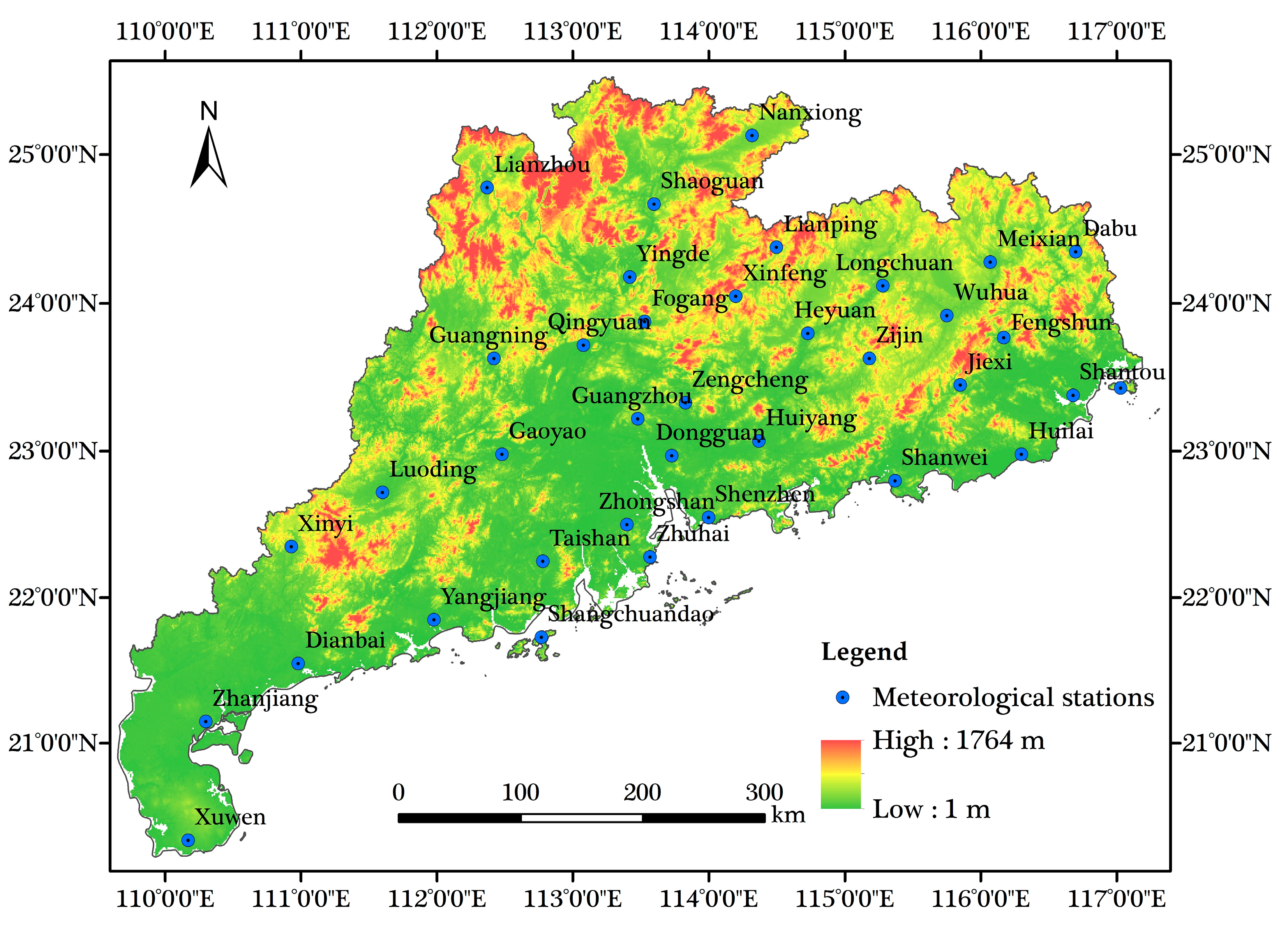
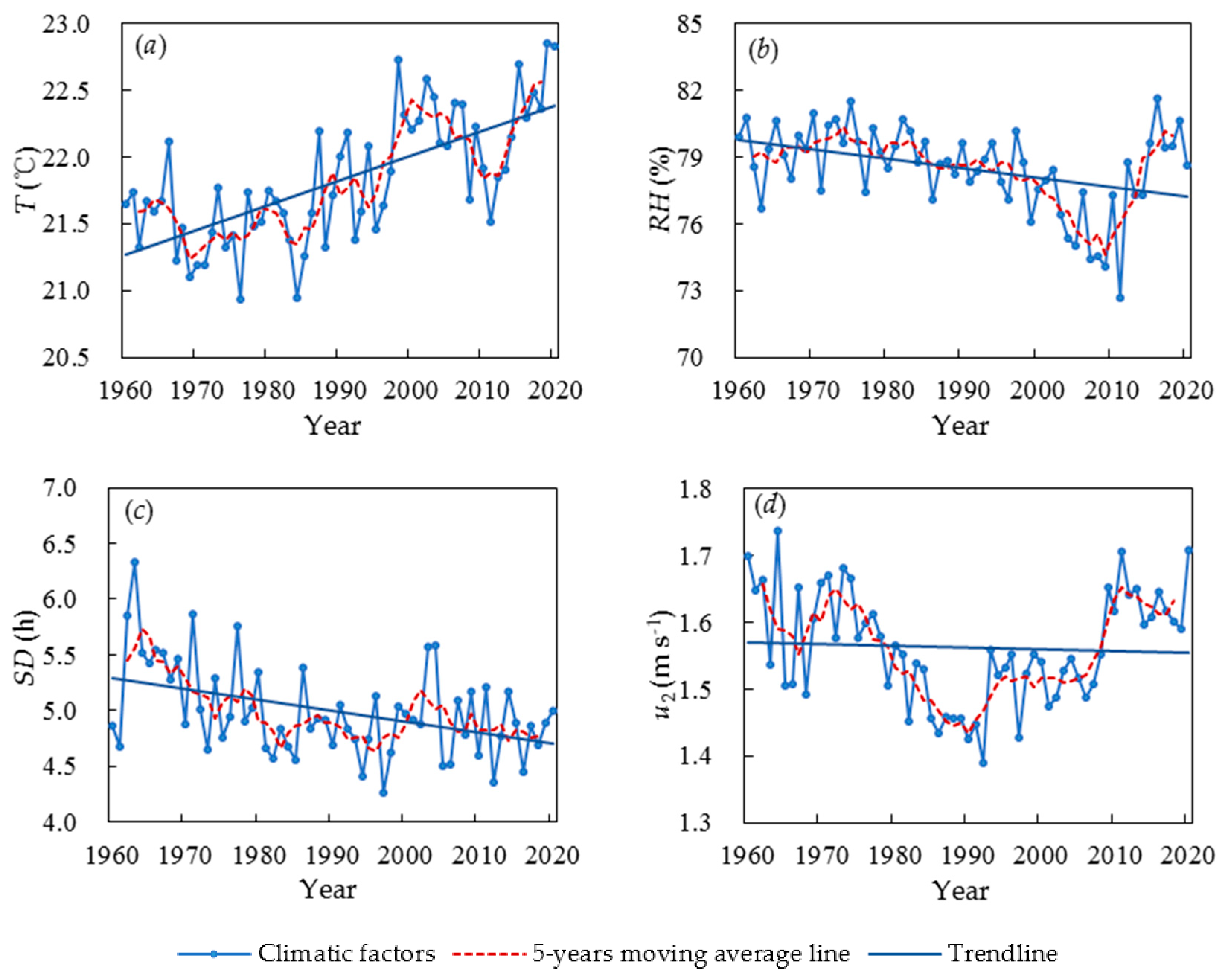
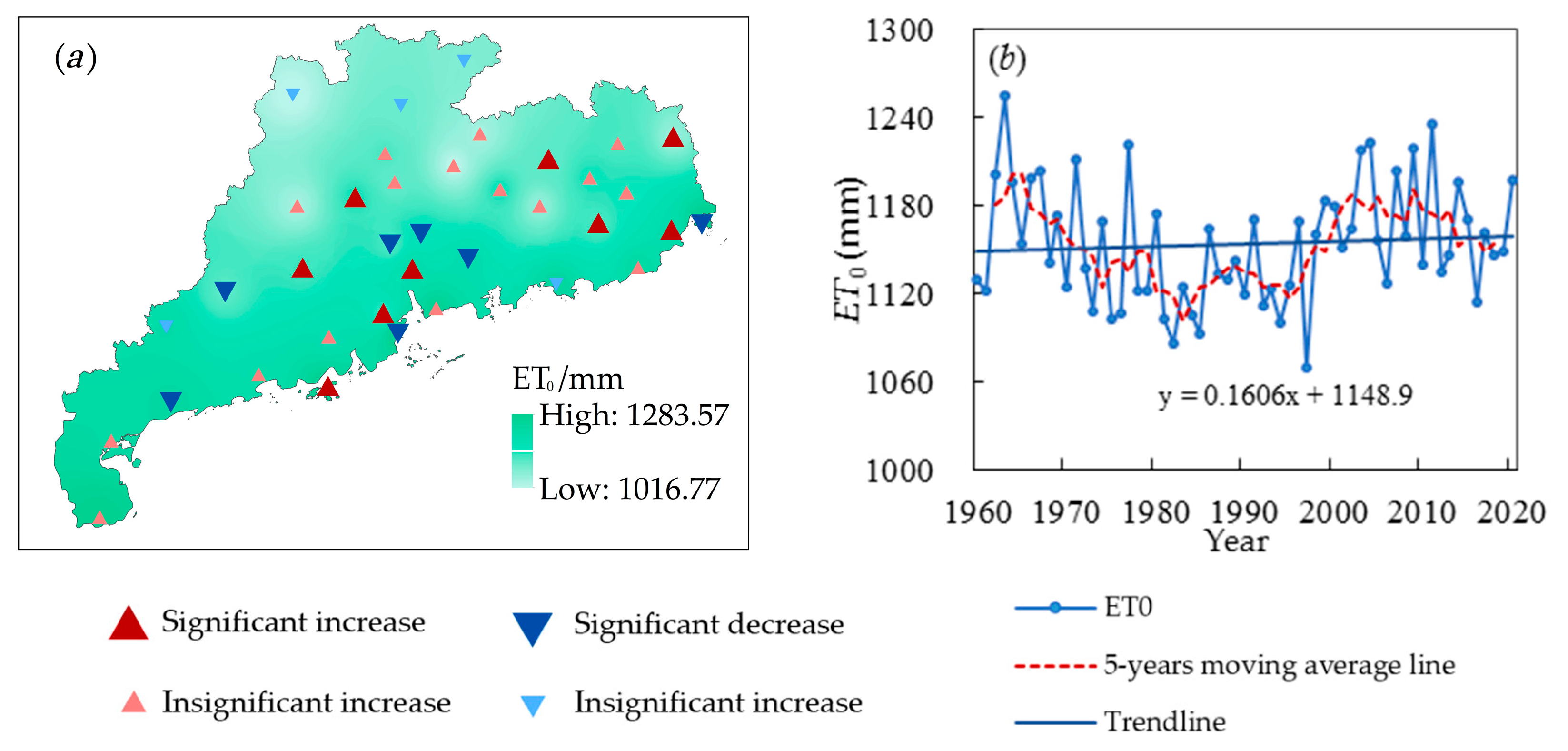
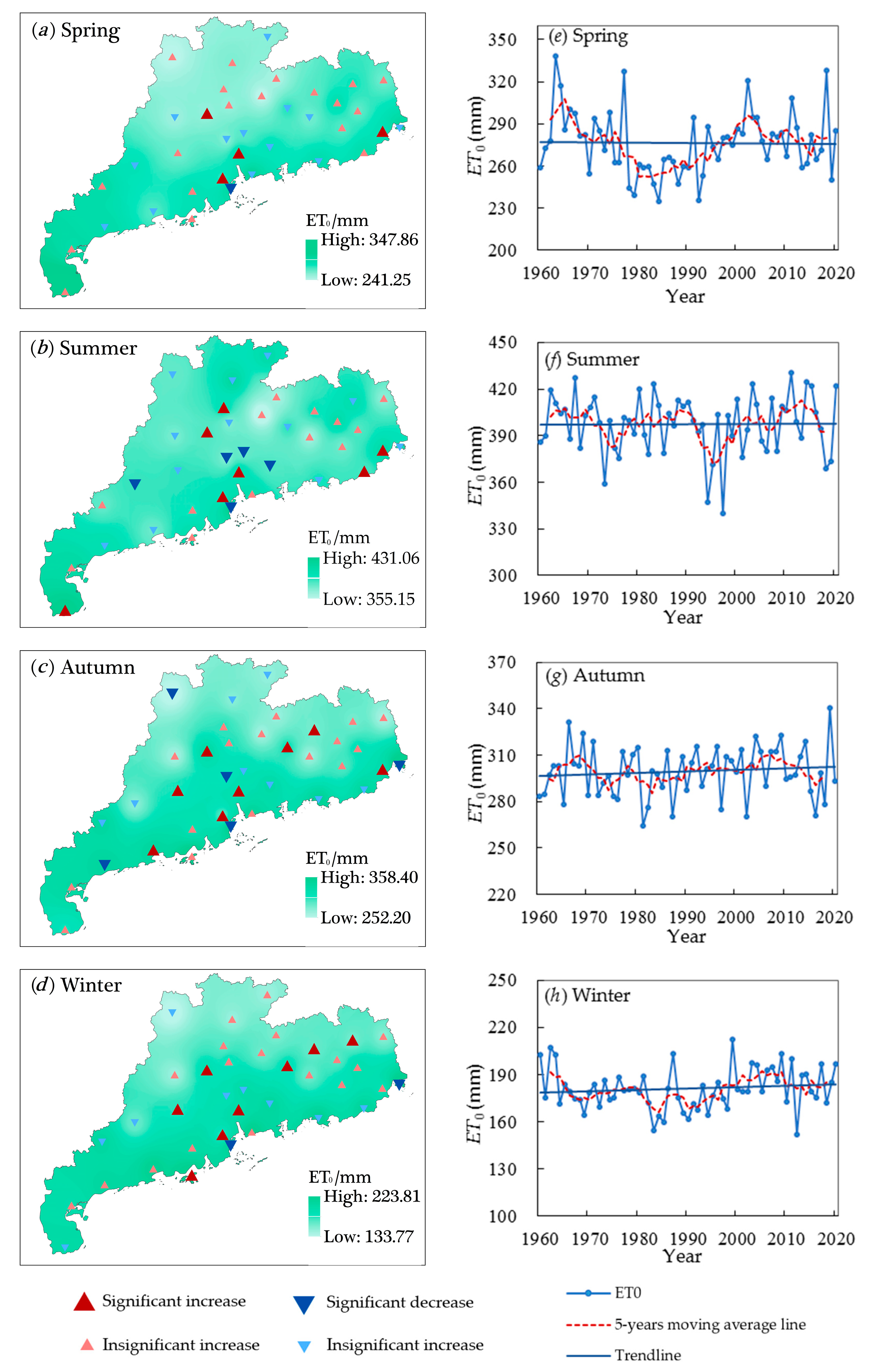




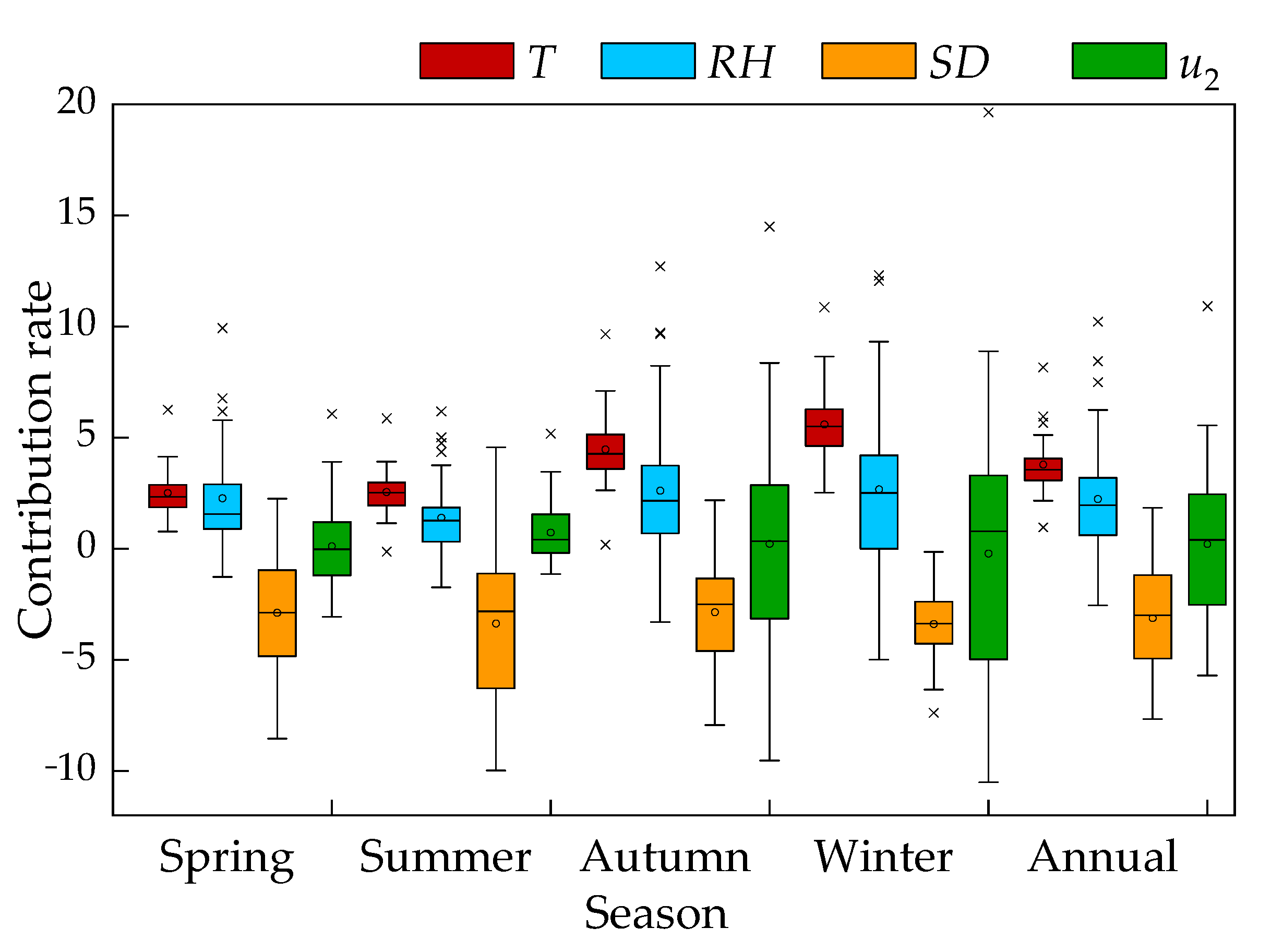
| Station Name | Station Code | Latitude (°) | Longitude (°) | Elevation (m) | T (°C) | P (mm year−1) | ET0 (mm year−1) |
|---|---|---|---|---|---|---|---|
| Nanxiong | 57996 | 25.08 | 114.25 | 149.7 | 20.60 | 1516.93 | 1086.92 |
| Lianzhou | 59072 | 24.82 | 112.37 | 131.7 | 20.59 | 1630.72 | 1017.50 |
| Shaoguan | 59082 | 24.67 | 113.60 | 121.3 | 21.24 | 1598.76 | 1102.62 |
| Fogang | 59087 | 23.88 | 113.52 | 97.2 | 21.87 | 2185.18 | 1110.86 |
| Yingde | 59088 | 24.18 | 113.42 | 74.4 | 21.86 | 1875.78 | 1125.04 |
| Lianping | 59096 | 24.38 | 114.50 | 283.9 | 21.06 | 1761.46 | 1045.66 |
| Xinfeng | 59097 | 24.03 | 114.22 | 269.3 | 21.29 | 1902.73 | 1021.50 |
| Longchuan | 59107 | 24.12 | 115.28 | 179.6 | 21.75 | 1676.19 | 1113.47 |
| Dabu | 59116 | 24.35 | 116.70 | 80.1 | 22.29 | 1504.85 | 1063.31 |
| Meixian | 59117 | 24.28 | 116.07 | 116.0 | 22.34 | 1497.09 | 1125.14 |
| Guangning | 59271 | 23.63 | 112.42 | 92.7 | 22.05 | 1721.33 | 1048.16 |
| Gaoyao | 59278 | 22.98 | 112.48 | 60.0 | 22.96 | 1641.14 | 1132.58 |
| Qingyuan | 59280 | 23.72 | 113.08 | 79.2 | 22.48 | 2125.33 | 1150.73 |
| Guangzhou | 59287 | 23.22 | 113.48 | 70.7 | 22.81 | 1809.36 | 1123.41 |
| Dongguan | 59289 | 22.97 | 113.73 | 56.0 | 23.14 | 1826.26 | 1195.20 |
| Heyuan | 59293 | 23.80 | 114.73 | 71.1 | 22.41 | 1922.63 | 1154.25 |
| Zengcheng | 59294 | 23.33 | 113.83 | 30.7 | 22.67 | 1965.49 | 1155.53 |
| Huiyang | 59298 | 23.07 | 114.37 | 108.5 | 22.87 | 1751.19 | 1191.59 |
| Wuhua | 59303 | 23.92 | 115.75 | 135.9 | 22.18 | 1499.91 | 1151.35 |
| Zijin | 59304 | 23.63 | 115.18 | 176.6 | 21.86 | 1706.80 | 1066.10 |
| Jiexi | 59306 | 23.45 | 115.85 | 80.9 | 22.42 | 2063.74 | 1123.96 |
| Fengshun | 59310 | 23.77 | 116.18 | 45.3 | 22.43 | 1830.54 | 1147.24 |
| Shantou | 59316 | 23.38 | 116.68 | 2.3 | 22.39 | 1556.30 | 1186.02 |
| Huilai | 59317 | 22.98 | 116.30 | 42.0 | 22.68 | 1792.25 | 1210.90 |
| Nan’ao | 59324 | 23.43 | 117.03 | 8.0 | 22.13 | 1357.39 | 1284.52 |
| Xinyi | 59456 | 22.35 | 110.93 | 141.4 | 23.47 | 1790.40 | 1201.36 |
| Luoding | 59462 | 22.72 | 111.60 | 60.0 | 23.12 | 1373.51 | 1114.67 |
| Taishan | 59478 | 22.25 | 112.78 | 33.1 | 22.89 | 1965.12 | 1183.24 |
| Zhongshan | 59485 | 22.50 | 113.40 | 33.7 | 22.97 | 1859.13 | 1134.09 |
| Zhuhai | 59488 | 22.28 | 113.57 | 51.4 | 23.17 | 2031.49 | 1271.63 |
| Shenzhen | 59493 | 22.55 | 114.00 | 63.0 | 23.36 | 1911.09 | 1252.23 |
| Shanwei | 59501 | 22.80 | 115.37 | 16.7 | 22.85 | 1899.26 | 1229.55 |
| Zhanjiang | 59658 | 21.15 | 110.30 | 53.4 | 23.84 | 1675.38 | 1214.12 |
| Yangjiang | 59663 | 21.85 | 111.98 | 90.3 | 23.11 | 2353.95 | 1189.67 |
| Dianbai | 59664 | 21.55 | 110.98 | 31.8 | 23.82 | 1550.61 | 1220.74 |
| Shangchuan Island | 59673 | 21.73 | 112.77 | 21.9 | 23.20 | 2244.92 | 1271.17 |
| Xuwen | 59754 | 20.25 | 110.17 | 11.4 | 24.54 | 1393.28 | 1271.18 |
| |Sx| | Sensitivity Level |
|---|---|
| |Sx| < 0.05 | Negligible |
| 0.05 ≤ |Sx| < 0.20 | Moderate |
| 0.20 ≤ |Sx| < 1.00 | High |
| |Sx| ≥ 1.00 | Very high |
| Climatic Factors | Mean Value | Linear Regression | MK Test | |||
|---|---|---|---|---|---|---|
| Slope | Std | Z | p-Value | Change Point (Year) | ||
| Spring | ||||||
| T (°C) | 22.25 | 0.015 | 0.74 | 2.41 | 0.008 | 2000, 2011 |
| RH (%) | 82.20 | −0.038 | 2.51 | −2.38 | 0.046 | 1963, 1994 |
| SD (h) | 3.50 | −0.008 | 0.74 | −0.94 | 0.132 | 1968 |
| u2 (m s−1) | 1.53 | −0.001 | 0.09 | −1.60 | 0.083 | 1964 |
| Summer | ||||||
| T (°C) | 28.65 | 0.016 | 0.30 | 5.63 | 0.000 | 1993 |
| RH (%) | 82.03 | −0.037 | 1.61 | −3.30 | 0.003 | 1983 |
| SD (h) | 6.28 | −0.010 | 0.60 | −2.30 | 0.027 | 1979 |
| u2 (m s−1) | 1.45 | 0.002 | 0.08 | 3.18 | 0.004 | 2010 |
| Autumn | ||||||
| T (°C) | 23.99 | 0.024 | 0.50 | 5.30 | 0.000 | 1995 |
| RH (%) | 75.27 | −0.057 | 3.04 | −2.47 | 0.014 | 1966 |
| SD (h) | 6.01 | -0.009 | 0.69 | −1.86 | 0.086 | 2011 |
| u2 (m s−1) | 1.58 | −0.0006 | 0.12 | −0.29 | 0.458 | - |
| Winter | ||||||
| T (°C) | 15.01 | 0.026 | 0.94 | 3.58 | 0.000 | 1991, 2011 |
| RH (%) | 74.42 | −0.036 | 3.31 | −1.60 | 0.142 | 1997 |
| SD (h) | 4.17 | −0.012 | 0.74 | −1.30 | 0.032 | - |
| u2 (m s−1) | 1.69 | −0.001 | 0.13 | −0.22 | 0.276 | - |
| Annual | ||||||
| T (°C) | 22.47 | 0.019 | 0.35 | 5.41 | 0.000 | 1999 |
| RH (%) | 78.48 | −0.042 | 1.73 | −3.33 | 0.002 | 1987 |
| SD (h) | 4.99 | −0.010 | 0.37 | −2.73 | 0.001 | 1973 |
| u2 (m s−1) | 1.56 | −0.0002 | 0.08 | −0.38 | 0.702 | - |
| Season | Mean Value | Linear Regression | MK Test | |||
|---|---|---|---|---|---|---|
| Slope | Std | Z | p-Value | Change Point (Year) | ||
| Spring | 3.00 | −0.0239 | 22.29 | 0.24 | 0.885 | 2000 |
| Summer | 4.32 | 0.0013 | 18.83 | 0.03 | 0.993 | 2003 |
| Autumn | 3.29 | 0.1004 | 15.92 | 0.91 | 0.397 | 1990 |
| Winter | 2.01 | 0.0828 | 12.97 | 1.23 | 0.392 | 2002 |
| Annual | 3.15 | 0.1606 | 40.58 | 0.83 | 0.594 | 2003 |
| Season | Relative Change Rc (%) | Sensitivity Coefficient Sx | Contribution Rate Cx (%) | ||||||||||
|---|---|---|---|---|---|---|---|---|---|---|---|---|---|
| T | RH | SD | u2 | ET0 | T | RH | SD | u2 | T | RH | SD | u2 | |
| Spring | 4.17 | −2.93 | −14.68 | 1.77 | −0.27 | 0.60 | −0.83 | 0.20 | 0.05 | 2.51 | 2.28 | −2.88 | 0.12 |
| Summer | 3.49 | −2.78 | −9.73 | 13.07 | 0.07 | 0.73 | −0.55 | 0.35 | 0.04 | 2.55 | 1.40 | −3.37 | 0.73 |
| Autumn | 6.11 | −4.61 | −9.26 | 3.95 | 2.15 | 0.73 | −0.63 | 0.31 | 0.13 | 4.47 | 2.61 | −2.86 | 0.22 |
| Winter | 10.40 | −3.15 | −17.58 | 0.92 | 3.22 | 0.54 | −0.94 | 0.19 | 0.15 | 5.59 | 2.67 | −3.39 | −0.22 |
| Annual | 6.04 | −3.37 | −12.81 | 4.93 | 1.29 | 0.65 | −0.73 | 0.26 | 0.09 | 3.78 | 2.24 | −3.12 | 0.21 |
Disclaimer/Publisher’s Note: The statements, opinions and data contained in all publications are solely those of the individual author(s) and contributor(s) and not of MDPI and/or the editor(s). MDPI and/or the editor(s) disclaim responsibility for any injury to people or property resulting from any ideas, methods, instructions or products referred to in the content. |
© 2023 by the authors. Licensee MDPI, Basel, Switzerland. This article is an open access article distributed under the terms and conditions of the Creative Commons Attribution (CC BY) license (https://creativecommons.org/licenses/by/4.0/).
Share and Cite
Zhao, B.; An, D.; Yan, C.; Yan, H.; Kong, R.; Su, J. Spatiotemporal Variations of Reference Evapotranspiration and Its Climatic Driving Factors in Guangdong, a Humid Subtropical Province of South China. Agronomy 2023, 13, 1446. https://doi.org/10.3390/agronomy13061446
Zhao B, An D, Yan C, Yan H, Kong R, Su J. Spatiotemporal Variations of Reference Evapotranspiration and Its Climatic Driving Factors in Guangdong, a Humid Subtropical Province of South China. Agronomy. 2023; 13(6):1446. https://doi.org/10.3390/agronomy13061446
Chicago/Turabian StyleZhao, Baoshan, Dongsheng An, Chengming Yan, Haofang Yan, Ran Kong, and Junbo Su. 2023. "Spatiotemporal Variations of Reference Evapotranspiration and Its Climatic Driving Factors in Guangdong, a Humid Subtropical Province of South China" Agronomy 13, no. 6: 1446. https://doi.org/10.3390/agronomy13061446






